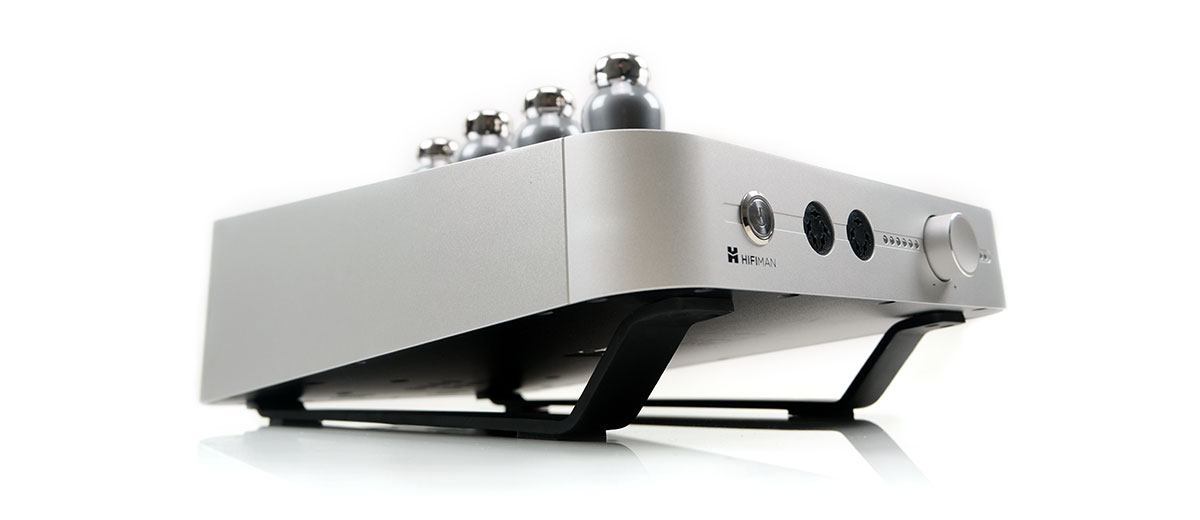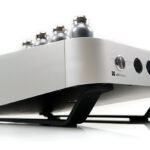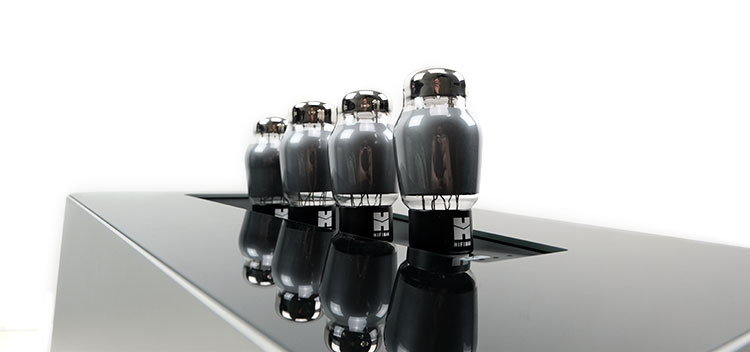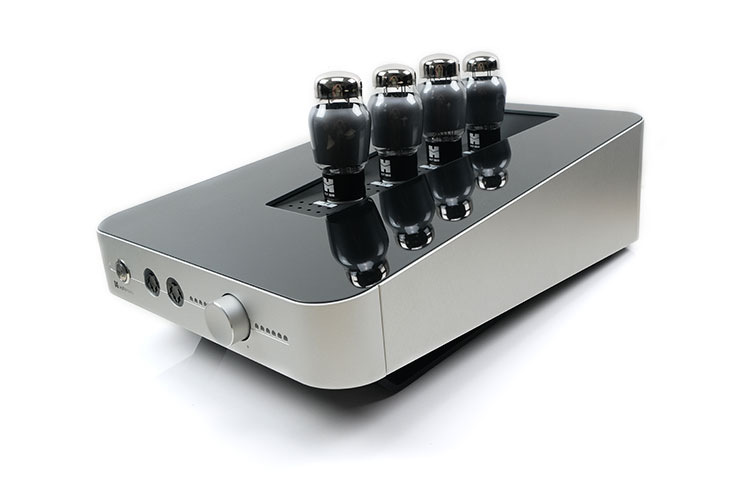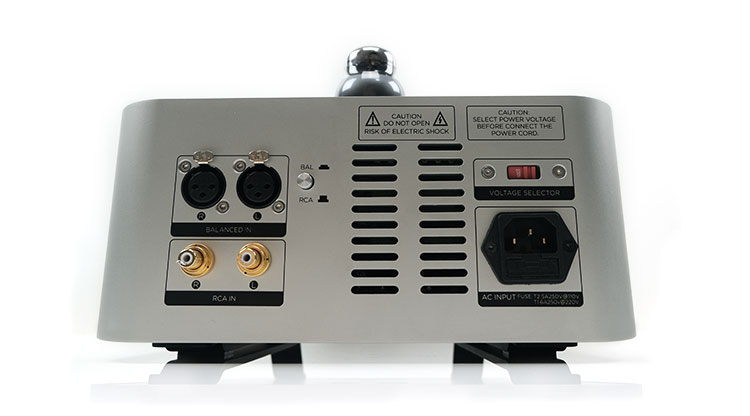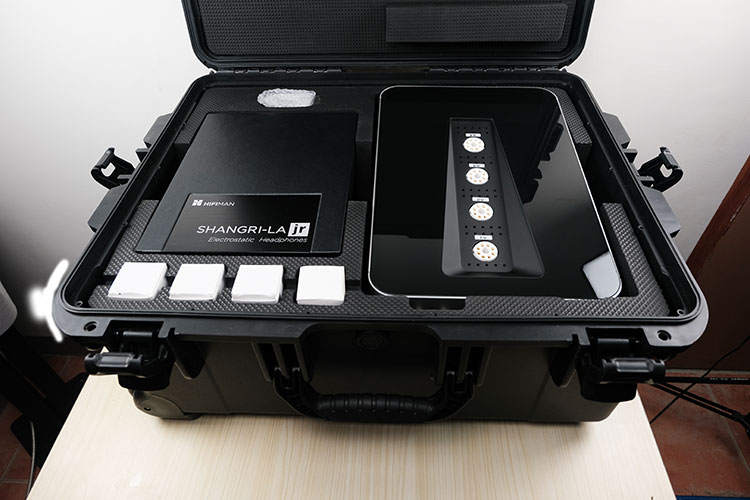The HIFIMAN Shangri-La Jr Amplifier is the hybrid solid-state and 6SN7 tube electrostatic companion to the Jr Headphones. It is priced at $5000.
Disclaimer: The amplifier sent to us was a purchased unit and does not have to be returned. Headfonics is an independent website with no affiliate links or services. We thank the team at Hifiman for their support during this review process.
To read more about the HIFIMAN products we have previously covered on Headfonics click here.
Note, this article follows our latest scoring guidelines which you can read up on here.
We reviewed and gave a Top Gear award to the Shangri-La Jr Headphones last year so you can consider this follow-up review on the system or matching amplifier as a part two of sorts.
The system, (headphones and amplifier), is priced at $8000 but you can get the amplifier on its own for $5000 currently at the HIFIMAN Direct store making it one of their more expensive amplifiers currently on sale.
This is the next electrostatic amplifier down from their statement Shangri-La ‘Senior’ statement amplifier and one that is much more affordable. The $15k hybrid tube and solid-state EF1000 is for non-electrostatic and can be bought on special order from HIFIMAN.
Tech Inside
The Shangri-La Jr amplifier is a hybrid 580v pro-bias compatible electrostatic amplifier. The hybrid aspect is a mix of 4 dual-triode 6SN7 tubes for the input stage and a solid-state circuit topology for the output stage.
Not much is known about the composition of the output stage and what exact type of amplifier is used inside. However, I would presume it is at the very least a Class AB and quite possibly a Class A. Given the price point and most equivalent Stax amplifiers are also Class A you would have to assume HIFIMAN is working on the same basis.
The tubes themselves are medium gain rated and not the GT or the GTB equivalents made by the likes of Sovtek or Tung-Sol.
In fact, there does seem to be an element of customization by HIFIMAN as they all have the company’s branding and more of a bulbous shape similar to more expensive variants from the likes of PSVANE or Natural Sound.
A quick check with our Stax equivalent in the office here would be the Stax SRM-007tII which uses four 6FQ7/6CG7 type tubes that are the historical successors and the electrical equivalent to the 6SN7.
Unfortunately, I have no officially rated maximum output levels in terms of Vrms or mA to offer you for the Shangri-La Jr amplifier. However, as a broad and subjective comparison, the amp did offer the same if not better headroom compared to the 340Vrms output rating of the Stax SRM-007tII.
Design
The Shangri-La Jr amplifier is a very unusually-shaped but elegant electrostatic amplifier. The chassis is a striking smoothly corners trapezoid or wedged form factor comprised of aviation-grade aluminum housing topped off with a highly reflective tempered glass pane in piano black.
This is not a huge amplifier volumetrically speaking at 276 x 270 x 116mm so it will not take up a huge amount of space but will need a strong flats surface for its 6.5Kg weight.
Inputs and venting are to the rear with a dual 580V 5-pin PO to the narrower front panel. You also get a matching silver-finished stepped attenuator in-between a LED volume indicator to the side beside.
On the base, there are two long and slightly angled black aluminum stabilizer rests that keep the off-shaped main amplifier housing stable and relatively horizontal for desktop use.
The smoked glass customized HIFIMAN branded 6SN7 tubes are housed in a recessed and visually striking vented center single isle. They are not protected with any grills so take care where to locate the amp so they are not exposed to potential knocks and can breathe properly.
I happen to think this is one of the classier-looking amplifier designs out there and a million miles away from the old-school shoebox styles.
Granted, with the shaping and elongated aluminum stabilizers on the base there is some shared design language from the newer and cheaper Jade II amplifier but that one feels more like a stripped-down and simplified version of the sexier Shangri-La Jr.
I/O
The Shangri-La Jr amplifier is a fully balanced topology so you do get a dual XLR balanced input to the rear alongside a set of gold-plated dual RCA inputs.
The dual 5-pin outputs to the front will allow you to connect two headphones at the same time though they are not independently linked to the individual inputs to the rear.
However, HIFIMAN has provided a balanced and SE controller to allow you to switch between the two source inputs when you require it. It is a bit of a flimsy button with some lateral movement but otherwise does the job it is designed to do.
To the far right, you have a voltage selector for either 110V or 230V operation with the PSU inside and a standard 3-prong AC input just below it.
The Shangri-La Jr amp also has a replaceable fuse tray just below the AC but be careful if you ever blow one and need to replace it as it’s a different rating for the voltage selected. For 110V it’s a T2 5A and for the 230V it’s a T5 6A rated fuse.
Controls
The Shangri-La Jr amplifier is pretty consistent with most electrostatic amps I have used before with a set of manual controls to the front.
To the far left is the power switch and do note, like most tube amps, there is a 30-second delay before the output stage is fully functional. There is a slim LED ring around the power button which will flash continuously during that period before becoming solid indicating you can start using the amp.
To the right is the volume control which is a relay-based attenuator with a 24-step level of volume control and a total of 23 separate resistors. Volume levels are indicated with a series of LED diodes to each side of the potentiometer so every 2 steps will light up 1 of 12 LEDs.
I found that suitable volumes would normally light up at least 6 of the LED, potentially 7-8 with more demanding headphones such as the VOCE. DAC input voltage and going balanced or SE will also affect listening volume levels to some extent so make sure you are hitting your default voltage input ratings of around 4V for balanced and 2V for SE.
The Shangri-La Jr amp also has a bias control at its base for correcting the operating conditions of the tube input stage. The stock tubes are matched and tested so out of the box you should not need to fiddle with this. However, if you want to tube roll then it might be useful for fine-tuning.
An incorrect bias setting can result in crossover distortion, inefficiency, and can cause damage to the tubes and amplifier. Normally this is done with a multimeter for voltage checking. Each tube input should be between 5-10V for normal operating conditions.
Packaging & Accessories
If you buy the system, you are going to get a huge weather-sealed luggage-sized container with a set of trolley wheels. It is probably the largest type of carrying case we have handled to date in the office though I am not entirely sure if you get the same setup when just ordering the amplifier alone.
The good news is that there is ample protection for the Shangri-La Jr Amplifier and tubes inside with come recessed strong black foam inserts.
The tubes come in their respective white cardboard boxes and are numbered 1-4 with corresponding 1-4 labels just below each tube base socket. Simply insert the matching numbered tube to the matching numbered socket before powering them up.
There are no other accessories save for a power cable and the headphones and its cute little stand if you bought the entire system. They come in their own packaging and protected foam locations inside the case.
Sound Impressions
The following impressions were completed using the HIFIMAN Shangri-La Jr Headphones and a HOLO Audio Spring DAC 2 Wildism Edition DAC.
Summary
Despite its hybrid amplification, the Shangri-La Jr amplifier delivers a sound signature closer to a classic tube sound than the solid-state side.
The only giveaway for me that this has a solid-state operational mode somewhere in the topology is the impactful low-end performance that rises above the likes of the similar hybrid dual-triode 6FQ7(6CG7) and Class A Stax SRM-007tII.
The Stax variant sounds a lot more linear to me, with less depth and a flatter staging quality but also a sweeter timbre with a livelier mids and treble performance. The Shangri-La Jr amp projects a bit more density and a more texture fuller sound with a better low-end fundamental.
With the Jr headphones pairing, the amplifier is rich-sounding, full-bodied, and with a slightly vocal forward delivery. You can tell that this amplifier and set of headphones were tuned for each other with almost perfect synergy and excellent resolution.
However, there is a degree of source sensitivity also so with a natural sounding DAC, it can sound relatively smooth on the attack with little in the way of brittle or lean treble. With a brighter DAC, the Jr headphones will lean a little to the edgier side from the upper mids onwards.
The Shangri-La Jr amplifier also has no problems driving more demanding electrostatic headphones either. There is plenty of headroom and dynamic range with the likes of the VOCE and the Audeze CRBN, two headphones that tend to drive up the volume a lot on lesser amps.
Timbre
The Shangri-La Jr amplifier delivers a bold yet natural-sounding instrumental and vocal timbre. You can easily get side-tracked into thinking its more to do with the tuning of the Jr headphones but we found that opening statement to be true with alternative electrostatic headphones such as the Audeze CRBN and the Stax 007MK2.
The Jr’s presentation sits somewhere in-between the more languid and neutral-bodied Stax SRM-007tII and the punchier but slightly drier toned VE Enterprise E Lite amplifier I have been using for a number of years now.
There is just a slight hint of softness in the attack and a slightly longer decay of the Jr timbre to give a more rounded tone through the mids and highs timbre. It keeps everything to the slightly more forgiving side, especially with R2R DAC sources that tend to bring a little more warmth and density to the performance.
The boldness statement comes from the excellent low-end performance of the Jr amplifier. It reaches deep, satisfyingly so with the CRBN and the Jr headphones lending a nice bit of authority and gravitas right up to midrange rock vocals which sound planted rather than lean.
I must caution it is not an overwhelming bass coloration and much will depend on the headphone of choice. You will get a lot more body from the 007MK2 heady bass tuning compared to the Jr’s own headphones, for example.
However, I do prefer the tighter bass balance from the Jr headphones and amplifier pairing. You get some nice richness and substance to lower mids guitar chords and bass plucks that can sound a bit leaner for me when switching to the SRM-007tII or softer and more laid back on the OTL-designed Kingsound M20 amplifier.
Staging & Dynamics
The headroom is excellently from the Shangri-La Jr amplifier so there should be no concerns at driving demanding electrostatic headphones such as the CRBN. You get a ‘big’ sounding presentation with excellent dynamic range and plenty of depth to go along with it.
Vocals are more to the fore also, at least compared to the more neutral imaging of the SRM-007tII and the Enterprise E Lite. Treble extends well but how much of it will present itself will depend on the headphone used and the DCA behind it. I did find it a bit more relaxed sounding compared to the two aforementioned amps when sharing the same DAC, (Holo Audio Spring DAC 2).
For example, the CRBN might need a bit more treble fizz whereas the Jr’s own headphones offer more high-end energy and forwardness. I suggest using a brighter DAC with the CRBN to tease out a clean high-energy treble performance, the Shangri-La Jr amp is sensitive enough to source coloration for that to work.
I would also suggest sticking with a balanced system setup for both DAC and amplifier. You get a superior level of channel separation, a slightly wider soundstage, and improved dynamic range over the single-ended input.
Click on page 2 below for pairings and select comparisons.

